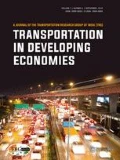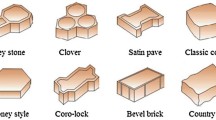Abstract
In concrete pavement, load transfer through the natural mechanism of interlocking action of the aggregate particles has been found to be effective for moderate to low traffic volume roads. This paper investigates the influences of some of the joint-related parameters (e.g., roughness, crack width and aggregate size) and pavement-related parameters (e.g., slab depth and modulus of subgrade reaction) on the load transfer efficiency (LTE) of an aggregate interlocked joint in concrete pavement. A three-dimensional finite element analysis of a jointed concrete pavement has been carried out. An aggregate interlocked joint with irregular fractured surfaces has been modeled in this work. The nature of the fractured surfaces or its roughness influences the LTE of the joint. The effects of varied roughness, crack widths and maximum aggregate size on the LTE of a joint have been investigated in the present work. It has been found that LTE increases with increase in roughness levels for all aggregate sizes and crack widths. The effects of depth of concrete slab and modulus of subgrade reaction on LTE have also been investigated. LTE has been found to increase with increase in slab depth; whereas it decreases with increase in the modulus of subgrade reaction.







Similar content being viewed by others
References
Yoder EJ, Witczak MW (1975) Principles of pavement design, 2nd edn. Wiley, Hoboken
Maitra SR, Reddy KS, Ramachandra LS (2009) Load transfer characteristics of dowel bar system in jointed concrete pavement. J Transp Eng ASCE 135(11):813–821
Maitra SR, Reddy KS, Ramachandra LS (2010) Load transfer characteristics of aggregate interlocking in concrete pavement. J Transp Eng ASCE 136(3):190–195
Ioannides AM, Korovesis GT (1990) Aggregate interlock: a pure shear load transfer mechanism. Transp Res Rec TRB 1286:14–24
Colley BE, Humphrey HM (1967) Aggregate Interlock at joints in concrete pavements. Bulletin 189:1–18
Jensen EA, Hansen W (2006) Nonlinear aggregate interlock model for concrete pavements. Int J Pavement Eng 7(4):261–273
Brink AC, Horak E, Visser A (2005) Improvement of aggregate interlock equation used in mechanistic design software. Int J Concr Pavements J Int Soc Concr Pavements 1(1):1–22
Arnold S, Fleming P, Austin S, Robins P (2005) A test method and deterioration model for joints and cracks in concrete slabs. Cem Concr Res 35(12):2371–2383
Pradena M, Houben L (2018) Load transfer-crack width relation of non-dowelled jointed plain concrete short slabs. The Baltic J Road Bridge Eng 13(1):40–45
Vandenbossche JM (2005) Using surface texture measurements of a fractured surface to determine the joint spring stiffness in a finite element model. In: Proceedings of workshop on fracture mechanics for concrete pavements: theory to practice, Colorado, USA, 2005
Huang YH, Wang ST (1973) Finite element analysis of concrete slabs and its implications on rigid pavement design. Highway Res Rec 466:55–79
Tabatabaie AM, Barenberg EJ (1980) Structural analysis of concrete pavement systems. J Transp Eng 106:493–506
Tia M, Armaghani JM, Wu CL, Lei S, Toye KL (1987) FEACONS III computer program for analysis of jointed concrete pavements. Transp Res Rec 1136:12–22
Zaman M, Alvappillai A (1995) Contact-element model for dynamic analysis of jointed concrete pavements. J Transp Eng 121(5):425–433
Vepa TS, George KP (1997) Deflection response models for cracked rigid pavements. J Transp Eng 123(5):377–384
Jeong JH, Zollinger DG (2001) Characterization of stiffness parameters in design of continuously reinforced and jointed pavements. Transp Res Rec 1778:54–63
Davids WG, Mahoney JP (1999) Experimental verification of rigid pavement joint load transfer modeling with EverFE. Transp Res Rec TRB 1684:81–89
Masad E, Taha R, Muhunthan B (1996) Finite-element analysis of temperature effects on plain-jointed concrete pavements. J Transp Eng 122(5):388–398
Nishizawa T, Koyanagawa M, Takeuchi Y, Kimura M (2001) Study on mechanical behavior of dowel bar in transverse joint of concrete pavement. In: Proceedings of the 7th international conference on concrete pavements, Orlando, Florida
Roesler J, Chupanit P (2005) Effect of coarse aggregate on concrete fracture energy and joint stiffness. In: Proceedings of workshop on fracture mechanics for concrete pavements: theory to practice, 2005, Colorado, USA
ANSYS Users’ Manual (2002) ANSYS Inc. Cannonsburg, PA
IRC: 58 (2015) Guidelines for the design of plain jointed rigid pavements for highways. In: The Indian Roads Congress, New Delhi, 2015
IS: 456 (2000) Plain and Reinforced Concrete—Code of Practice. In: Bureau of Indian Standards, New Delhi, 2000
IRC: 15 (2011) Standard specifications and code of practice for construction of concrete roads. In: The Indian Roads Congress, New Delhi
Reddy KS (1993) Analytical evaluation of bituminous pavements, Ph.D. Thesis, Indian Institute of Technology Kharagpur, India
Hillerborg A, Modeer M, Petersson P-E (1976) Analysis of crack formation and crack growth in concrete by means of fracture mechanics and finite elements. Cem Concr Res 6:773–782
Maitra SR, Reddy KS, Ramachandra LS (2014) Numerical investigation of fatigue characteristics of concrete pavement. Int J Fract 189:181–193
Acknowledgement
The authors acknowledge the opportunity to present the research work that forms the basis of this article at the 4th Conference of the Transportation Research Group of India held at IIT Bombay, Mumbai from 17 to 20 December, 2017.
Author information
Authors and Affiliations
Corresponding author
Additional information
Publisher's Note
Springer Nature remains neutral with regard to jurisdictional claims in published maps and institutional affiliations.
Rights and permissions
About this article
Cite this article
Maitra, S.R., Reddy, K.S. & Ramachandra, L.S. Effect of Joint- and Pavement-Related Parameters on Load Transfer Characteristics of Aggregate Interlocked Jointed Concrete Pavement. Transp. in Dev. Econ. 5, 15 (2019). https://doi.org/10.1007/s40890-019-0080-x
Received:
Accepted:
Published:
DOI: https://doi.org/10.1007/s40890-019-0080-x




